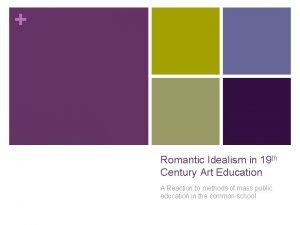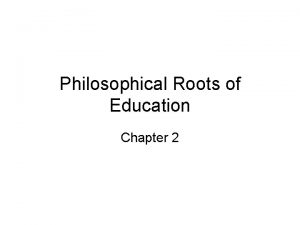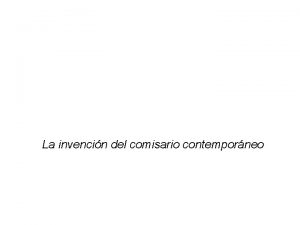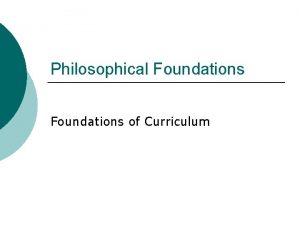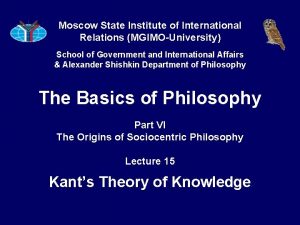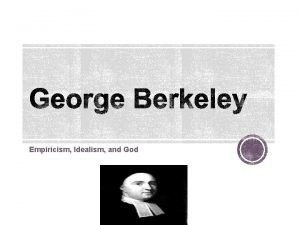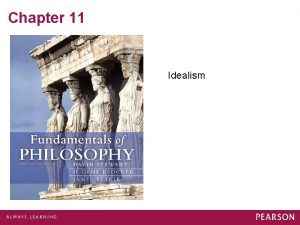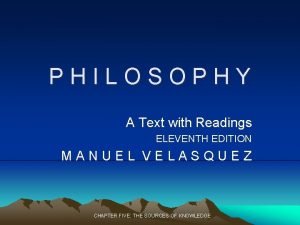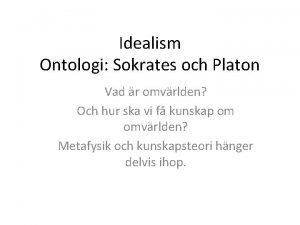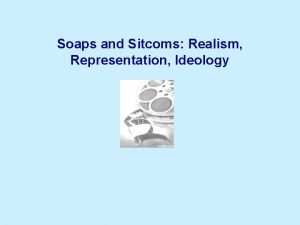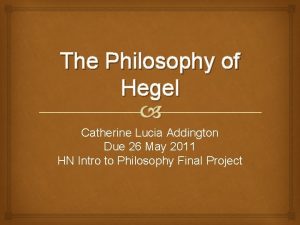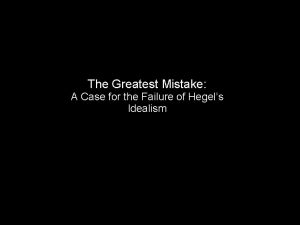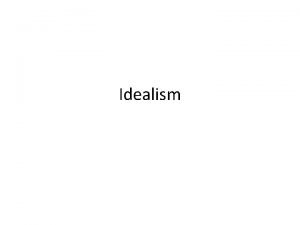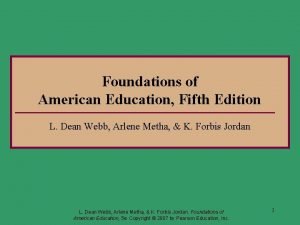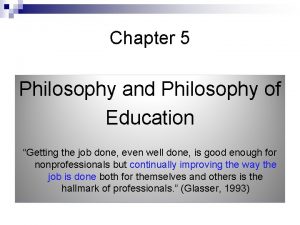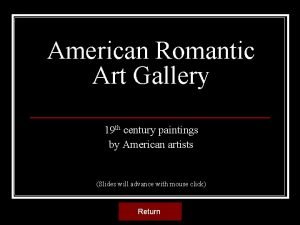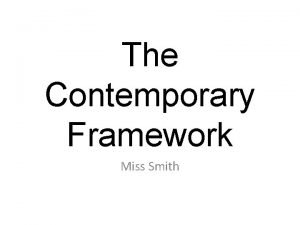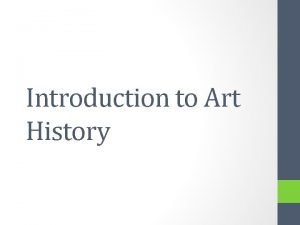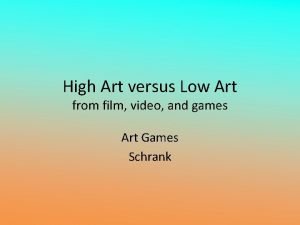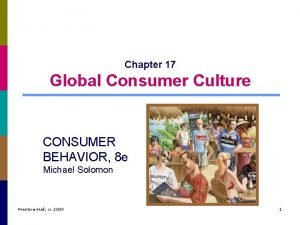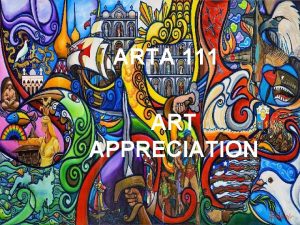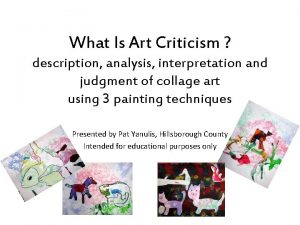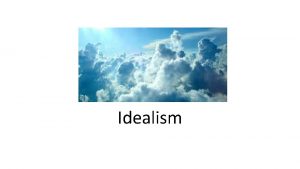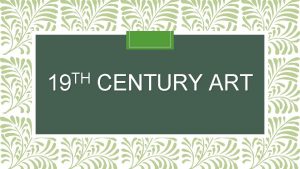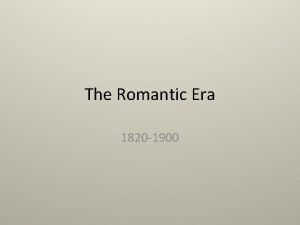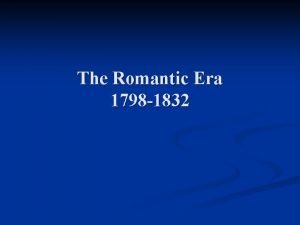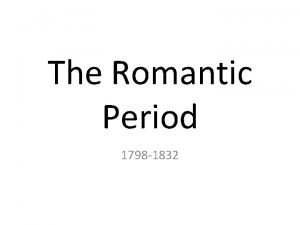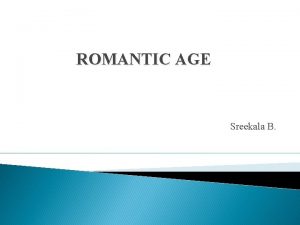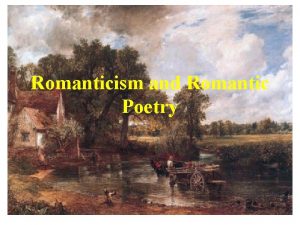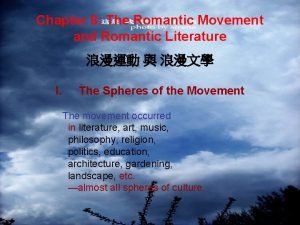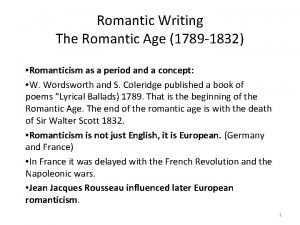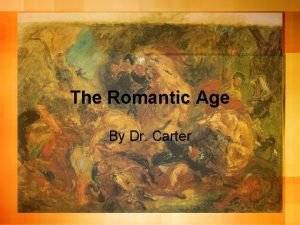Romantic Idealism in 19 th Century Art Education



























- Slides: 27

+ Romantic Idealism in 19 th Century Art Education A Reaction to methods of mass public education in the common school

+ What’s the big idea of Idealist thought? n Transforming the arts from “ornamental, polite learning” to subjects rich in moral purpose n Art is important!. . . because it can raise the level of public morals n Mind as active process (Kant) n Self-expression/Artistic perception/Moral beauty (German idealism-Ruskin)

+ America & Idealism: Two paths n New England Transcendentalists (N. E. T. ) n Amos Bronson Alcott n Elizabeth Peabody n Interpretation n William of Hegel Torrey Harris

+ New England Transcendentalists n Antiestablishment, attempt at utopia (Nature/Democracy vs. Established Society) n Human “perfectability” through individual’s own efforts n Industrialization= n n Material wealth n Urban crowding/Human misery Kantian philosophy: Awareness of nature through faculty of perception n We can transcend the senses (perception) by intuition n Universal mind

+ Alcott & Peabody n 1834 -Boston-Liberal ideals n Alternatives to traditional education beginning to develop n Alcott: “Conversations” at the School for Human Culture n Met Elizabeth Peabody in 1834, opened Temple School n Transcendental beliefs, 3 divisions of subject matter n Rational faculty n Imaginative faculty n Spiritual faculty

+ Alcott & Peabody (cont. ) Decoration in the Classroom n Ideal school setting: Surrounding of Natural Beauty n However, school was in the city (Boston) because, “that’s where the children were” (p. 118). n So, classrooms were decorated with “beautiful” things…artwork, busts, bookshelves n Anticipated by 50 years the movement to decorate schoolrooms

+ Criticism of the Temple School n By its third year, Peabody becomes disillusioned n “Conversations” lead to Gospels n “Saintliness” of children could lead to immodesty, superiority complex n “Conversations” about taboo subjects n Birth/Love/Death/Conception/Circumcision n Alcott’s Conversations With Children on the Gospels became object of public censure and ridicule n Despite drawing instructor (Francis Graeter), drawing played minor role in curriculum

+ Friedrich Froebel: Kindergarten n 1817 -founded the Universal German Educational Institution n 1826 -published The Education of Man n Philosophy of Education: The world as organic unity n n Unity within diversity is spiritual principle of God Parts contribute to the whole! n “Through development, the self both differentiates itself from and integrates itself into the community” (p. 121). n Essential feature of the mind is activity

+ Froebel’s Kindergarten of Children) (Garden n Development=a means of self-realization, not just representing the environment n Life=learning to know oneself through learning to know the objective world n Curriculum=principle n “The of play educator, like the gardener, has to provide the proper conditions for growth, and the kindergarten is the place where these conditions are created” (p. 122).

+ “Gifts & Occupations” n Objects/Materials n Introduction n Enable for individual and group activities of art media to school environment child to find unity in diversity in the forms and patterns of things n Mathematical principles/Harmony of universe

+ “Gifts” include: n n n Woolen balls in primary and secondary colors n Similarity/contrast, color mixing n Play—ball=game Objects made of wood: sphere, cube, cylinder n Compare/contrast with woolen balls n Smooth/Rough, Light/Heavy, Sounds made when dropped Blocks: Whole is made up of parts! n Play/Construction n Surfaces: color, design, patterns n Drawing on slate with grid lines

+ “Occupations” n Involve transformation of material n Demand greater dexterity and precision than developmental level may allow n Include: n Perforating paper to make designs n Sewing on cards with colored thread n Paper cutting and mounting n Braiding and weaving n Paper folding n Clay modeling

+ Kindergarten movement suppressed in late 1840 s n Revolution of 1848 in Germany=political conservatism n Froebel dies in 1852 n Baroness von Bulow becomes spokesperson for kindergarten movement in Germany and throughout Europe

+ American Kindergarten Movement (so many names, so many connections!) n First established by German-speaking immigrants n 1855 -Mrs. Carl Schurz est. kindergarten in Watertown, WI n Introduces Froebel’s ideas to Elizabeth Peabody n Peabody opens first English-speaking kindergarten in Boston n Begins journal to explain/spread the movement n Susan Blow-St. Louis, MO-supported by William Torrey Harris n 1873 -est. first training school in U. S. for kindergarten teachers n Emma Marwedel-helped est. first kindergarten on west coast n Golden Gate Kindergarten Association

+ American advocates of kindergartens stress that: n Gifts & Occupations could provide foundation for industrial education n Industrial drawing program of Walter Smith + educational systems in Germany = more creative children n 1870 -Massachusetts Drawing Act and introduction of kindergarten into Boston schools n Due to rising interest in vocational education n Men with power (and money) bring about changes in schools to fit their interests

+ Commercial Distribution of and Occupations Gifts n Need to manufacture and distribute materials for the classroom n Milton Bradley Company n n After meeting with Peabody, Bradley was devoted to providing a means for Froebel’s ideas to be put to use in schools n Published The Paradise of Childhood by Edward Wiebe-a teacher’s manual for using gifts and occupations Other vendors: E. Steiger Co. & Prang Educational Co.

+ Art Activities n Mary Dana Hicks (Louis Prang’s 2 nd wife) n 1891 -addressed NEA about Type forms (3 -D models for drawing) n Psychology of perception n Transformed gifts & occupations to Art activities

+ The 4 Great Institutions • Family • Civil Society • The State • The Church William Torrey Harris Valued the arts because: They are one of the 3 ways in which human thought reaches toward the divine. 1. Religion 2. Art 3. Philosophy Art should be taught “in order that men may be able to appreciate and produce the beautiful. ” 1835 -1909 • Appointed superintendent of schools for St. Louis in 1868 • Commissioner of Education for the United States 1889 -1906

+ John Ruskin 1819 -1900 n Believed that it was important for the emergent middle class to become sufficiently knowledgeable of art n Believed that art was a source of spiritual truth. n Not recreational or for amusement n Two aspects involved in creating and responding to art: “perception” and “invention”

+ Invention vs. Perception Ruskin believed that the power of invention was Godgiven, and could not be taught Perception, however, could be taught. Art education was to help students perceive the beauties of God’s work. Drawing could improve perception Ruskin thought that by teaching art, one could teach everything. Integrating history and the natural sciences.

+ Ruskin at Oxford Ruskin’s work as an Oxford professor took 3 forms: 1. Lectures on art 2. Founding a collection of artworks to illustrate good art 3. Establishment of a drawing mastership Ruskin designed the drawing mastership to replace the South Kensington system at Oxford

+ The South Kensington System Design could be taught by rule, as a branch of manufacturing activity Different types of students took different combinations of classes • Machinists, engineers, and foremen of works took a specific set of technical studies courses • Designers and ornamentalists took all courses

+ The Promotion of School Decoration • Ruskin believed that one’s surroundings was influential in developing good taste • The development of taste was a critical part of education the child to become a civilized adult. • Ruskin supported the use of fine art reproductions in schools.

+ Whistler vs. Ruskin • In 1877 Ruskin bumped heads with painter, James Mc. Neill Whistler • Ruskin believed in art as a serious moral undertaking, while Whistler believed that an artist’s primary task was to create art. • Ruskin found Whistler’s work offensive and critiqued his work as “flinging a pot of paint in the public’s face” and being overpriced. • Whistler sued for libel

+ Whistler vs. Ruskin Whistler’s attorney tried to prove that he was an accepted, successful artist, but his reputation was damaged by Ruskin’s criticism. • • Ruskin’s attorney tried to prove that Whistler spent little time or effort in his paintings, but still sold them for outrageous prices. • Whistler defended himself by explaining his view of art-for-art’s-sake. Whistler was awarded damages of one farthing (1/4 of a penny) • Ruskin still regarded this as a defeat and resigned from Oxford.

+ Art in the Education of Women in 19 th century America • women teachers used art to teach moral values • drawing studies were reserved for young women who came from wealthy families • rarely offered to women in public institutions, but often in private education • young women were taught drawing, literature, elocution, and French – to prepare them for marriage.

+ Art in the Education of Women in 19 th century America • Reverend Joseph Emerson worked to elevate the system of female education. • Critics believed that a woman’s mind was incapable of higher culture. • A number of schools in Massachusetts at this time proved that girls could learn as well as boys, using the same instructional approaches
 Romantic idealism
Romantic idealism Metaphysics branches
Metaphysics branches Art pretest
Art pretest Harald szeemann documenta 5
Harald szeemann documenta 5 Perennialism curriculum
Perennialism curriculum Empiricism and rationalism
Empiricism and rationalism Secondary qualities locke
Secondary qualities locke Berkeley subjective idealism
Berkeley subjective idealism Transcendental idealism
Transcendental idealism Platon sokrates
Platon sokrates Idealistic realism
Idealistic realism Idealism
Idealism Catherine lucia
Catherine lucia Absolute idealism
Absolute idealism Berkeley subjective idealism
Berkeley subjective idealism Axiology of idealism
Axiology of idealism Essentialism in the classroom
Essentialism in the classroom Romantic instruments
Romantic instruments Hegel classical art
Hegel classical art The romantic period in american literature
The romantic period in american literature Art_gallery_19
Art_gallery_19 Characteristics of romantic
Characteristics of romantic Contemporary frameworks
Contemporary frameworks Art appreciation introduction
Art appreciation introduction High art vs low art
High art vs low art What is high art and low art
What is high art and low art Arts appreciation subject
Arts appreciation subject Art analysis vs art interpretation
Art analysis vs art interpretation
